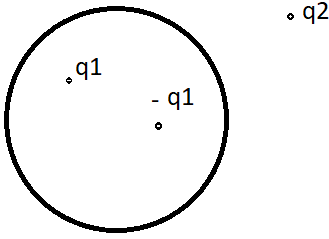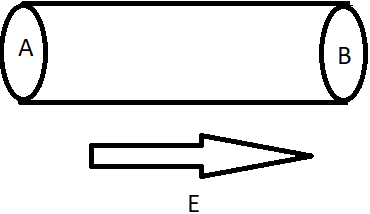This set of Class 12 Physics Chapter 1 Multiple Choice Questions & Answers (MCQs) focuses on “Gauss’s Law”.
1. What is the number of electric field lines coming out from a 1C charge?
a) 9*109
b) 8.85*10-12
c) \(\frac {1}{8.85}\)*10-12
d) Infinite
View Answer
Explanation: According to Gauss’s Law, the total number of electric field lines coming out of a charge q is = \(\frac {q}{\varepsilon_o}\) where εo is the absolute permittivity of air. Its value is 8.85*10-12. Therefore the number of lines coming out from a 1C charge = \(\frac {1}{8.85}\)*10-12.
2. Electric field outside this Gaussian surface will be ___________

a) Only for q2
b) Only for positive charges
c) Zero
d) For all the charges
View Answer
Explanation: According to Gauss’s Law, the electric field outside a closed surface will be only because of the total charge enclosed inside the surface. In this case, there are two positive and negative charges of the same magnitude inside the surface. Therefore the net charge inside the surface is zero. Therefore electric field outside the surface will also be zero. There will be no effect of the second charge q2.
3. An electric charge q is placed at one of the corner points of a cube of side a. What will be the net outwards flux coming out of the cube due to the point charge?
a) \(\frac {q}{\varepsilon_o}\)
b) \(\frac {q}{2\varepsilon_o}\)
c) \(\frac {q}{4\varepsilon_o}\)
d) \(\frac {q}{8\varepsilon_o}\)
View Answer
Explanation: We can assume 8 imaginary cubes, all of side a placed together, sharing a common corner point and forming a bigger cube of side 2a. The point charge is placed at the common point of the cubes. According to Gauss’s Law, net electric flux coming out of the bigger cube=\(\frac {q}{\varepsilon_o}\). Therefore, flux coming out from each of the smaller cubes i.e. cubes of side a is \(\frac {q}{8\varepsilon_o}\).
4. What will be the total flux passing through the cylinder if the surface A and B have surface area S?

a) ES
b) –ES
c) Zero
d) \(\frac {ES}{\varepsilon_o}\)
View Answer
Explanation: The electric field is directed from left to right. Therefore, net flux coming is the surface A is ES and the net flux coming out of the surface B is ES. But there is no flux along the curved surface area of the cylinder because the area vector is perpendicular to the field direction. Hence the net flux linked to the cylinder is zero.
5. 8 electric dipoles having charges e are placed at the center of a cube. The net flux coming out of the cube surface is _________
a) Zero
b) \(\frac {e}{\varepsilon_o}\)
c) \(\frac {8e}{\varepsilon_o}\)
d) \(\frac {16e}{\varepsilon_o}\)
View Answer
Explanation: Electric dipole is the combination of a couple of positive and negative charges having the same magnitude. Therefore, the total charge of an electric dipole is 0. That means the total charge inside the cube is zero and according to Gauss’s Law, the net electric flux coming out of the cube is zero.
6. Net inward and outward flux of a closed surface are φ1 and φ2. What is the charge enclosed inside the surface?
a) Zero
b) -(∅1-∅2)εo
c) (∅1-∅2)εo
d) \(\frac {(\emptyset_1 + \emptyset_2)}{\varepsilon_o}\)
View Answer
Explanation: The net outward flux from the surface is (∅2-∅1) = -(∅1-∅2). We know, according to Gauss’s Law, net outward flux coming out of a closed surface is \(\frac {1}{\varepsilon_o}\) times the charge stored in it. Therefore charge stored in the surface = εo*flux coming out of the surface = (∅2-∅1)εo.
7. An electric field E is present perpendicular to a square plate of side length L. What is the flux passing through the plate?
a) LE
b) L2E
c) \(\frac {L^2}{E}\)
d) Zero
View Answer
Explanation: We know that electric flux is equal to the product of the electric field and the surface area of a surface. In this case, the plate has surface area L*L = L2 and hence the net flux passing through the surface is = L2E.
8. Gauss’s Law is applicable only in the case of the electric field. This statement is __________
a) True
b) False
View Answer
Explanation: Though Gauss gave his law for the electric field only, this rule is applicable in the case of the magnetic field also. In that case, magnetic flux lines are counted and the permittivity of the medium is replaced by the permeability of the medium. This law is also applicable in the gravitational field.
9. In the CGS system, \(\frac {1}{\varepsilon_o}\) is replaced by _______ if k is the dielectric constant of the medium.
a) \(\frac {4\pi}{k}\)
b) \(\frac {2\pi}{k}\)
c) \(\frac {1}{k}\)
d) 1
View Answer
Explanation: In the SI system, Gauss law states that flux= (\(\frac {1}{\varepsilon_o}\))*electric charge. But is the CGS system, the law states that, flux= \((\frac {4\pi}{k})\)*electric charge [where k is the dielectric constant of the medium]. Therefore we have to replace (\(\frac {1}{\varepsilon_o}\)) with (\(\frac {4\pi}{k}\)).
10. A non-conducting sphere has uniform charge density in it. The electric field at a point inside the sphere will be _______
a) Zero
b) Only due to the charge inside that point
c) Only due to the charge outside that point
d) Due to the entire charge of the sphere
View Answer
Explanation: In the case of a non-conducting sphere, an electric charge is uniformly distributed throughout the sphere. Inside the sphere, the electric field at a point will be only due to the electric charge inside that point. There will be no effect of the remaining charge outside that point. In the case of the conducting sphere, the electric field at every point inside the sphere is zero.
11. An electric field \(3\hat{j} + 4\hat{k}\) N/C is present at a place. What will be the electric flux passing through a square plate if the plate is placed in the y-z plane?
a) 7 Nm2C-1
b) 25 Nm2C-1
c) Zero
d) 17 Nm2C-1
View Answer
Explanation: The electric field is present in the y-z plane. So, if we place a square surface in the y-z plane, the area vector of the plane will be perpendicular to the electric field and hence cosθ becomes 0 as θ is 90 degrees. So, E*surface area*cosθ becomes zero i.e. no flux through the surface.
Sanfoundry Global Education & Learning Series – Physics – Class 12.
To practice all chapters and topics of class 12 Physics, here is complete set of 1000+ Multiple Choice Questions and Answers.
If you find a mistake in question / option / answer, kindly take a screenshot and email to [email protected]
- Practice Class 12 - Mathematics MCQs
- Check Class 12 - Physics Books
- Practice Class 12 - Chemistry MCQs
- Practice Class 11 - Physics MCQs
- Practice Class 12 - Biology MCQs
